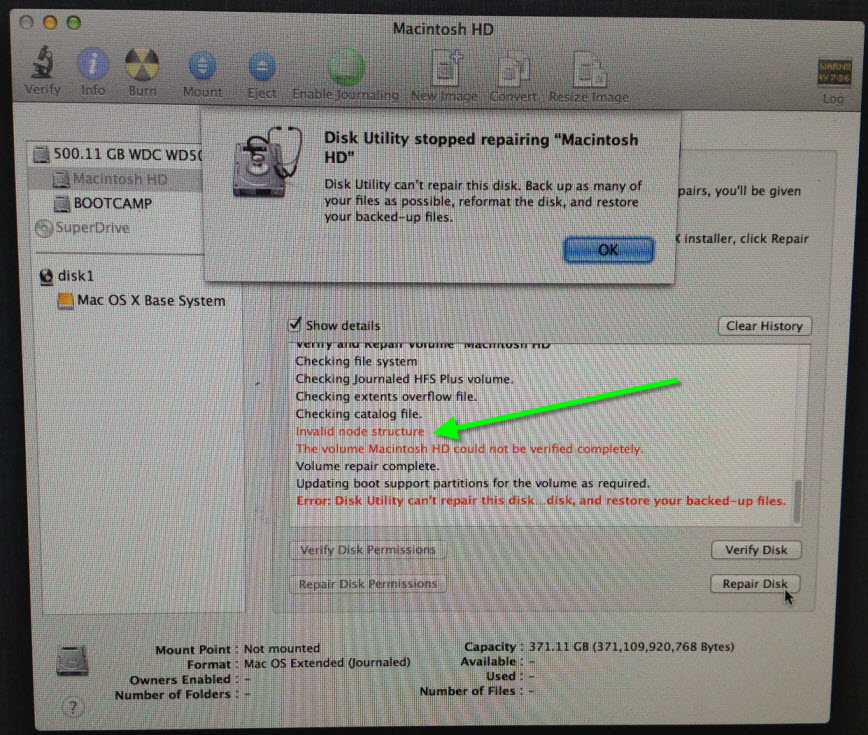Mac Disk Unitlity Unable To Unmount Volume For Repair
Thank you for using Apple Support Communities. It seems like you want to repair your external drive but it is giving you an error that it is not able to unmount and repair. I would recommend you read this article and use it to help troubleshoot the issue.
Had that problem today on a dual boot disk (Window+macOS) today, wanting to fresh-reinstall macOS on the partition it was installed before; having that issue, I've spent a lot of time trying to repair my partitions under Windows or Disk Utility (from the USB installer). Finally, what worked was. Problem 4: Unable to unmount volume for repair macOS. If the High Sierra installation is stuck because of the error: Unable to unmount volume for repair macOS, unmount the disk manually. Hold down Option + Command + R while restarting your Mac. Your Mac will enter internet recovery mode. Open the Terminal and type: diskutil list. Hit Enter key.
Free download game battle city tank 1990 for pc games. Battle city tank 1990 free download - Tank Battle 1990 for Windows 10, Super Tank - Battle City 1990, Battle City - Super Tank 1990, and many more programs. Do you remember the super tank 1990. Jump into multiple levels inspired by the classic NES tank game at the comfort of your PC. Download, play and share the magnificently desktop PC-ported Super Tank – Battle City 1990 game with your friends and family. A Classic Game Reinvented for PC. The game comes with all the classic elements seen from the original NES game of the same title. Battle City - Super Tank 1990 for Windows 10. Battle City Tank 90. Sid Meier's Civilization V is the fifth offering in the multi-award winning Civilization turn-based PC strategy game series.
If you try to verify a volume that is not your startup disk but for some reason Disk Utility can't unmount the volume (for example, the disk may have open files), the verification will appear to start but then stop without displaying any alert message. If you look in the Console (/Applications/Utilities/), you will see an entry like this:
Verifying volume “Storage” The disk “Storage” could not be unmounted Could not unmount disk for verification, attempting live verify
If you try to repair a disk that cannot be unmounted, the repair will appear to start, but then stop as Disk Utility displays this message: 'Repairing disk failed with error. Could not unmount disk.'
If you look in the Console (/Applications/Utilities/), you will see an entry like this:
Verify and Repair disk 'Storage.' The disk “Storage” could not be unmounted. Could not unmount disk for verification. Repairing disk failed with error. Could not unmount disk.
In some rare situations, your computer might not respond for several seconds.
If you cannot determine which files are open on the disk that you want to verify or repair, restart your computer and then mount the disk again, or start up from your Mac OS X Install DVD or CD to repair.
Using Disk Utility to verify or repair disks
Take care.
Jan 31, 2017 1:38 PM
Disk Utility User Guide

Disk Utility can fix certain disk problems—for example, multiple apps quit unexpectedly, a file is corrupted, an external device doesn’t work properly, or your computer won’t start up. Disk Utility can’t detect or repair all problems that a disk may have.
If you run First Aid on a disk, Disk Utility checks the partition maps on the disk and performs some additional checks, and then checks each volume. If you run First Aid on a volume, Disk Utility verifies all the contents of that volume only.
In the Disk Utility app on your Mac, choose View > Show All Devices.
Note: If you’re checking your startup disk or startup volume, restart your computer in macOS Recovery, select Disk Utility in the macOS Utilities window, then click Continue. If you check your startup volume (Macintosh HD), make sure you also check your data volume (Macintosh HD - Data).
In the sidebar, select a disk or volume, then click the First Aid button .
If Disk Utility tells you the disk is about to fail, back up your data and replace the disk—you can’t repair it. Otherwise, continue to the next step.
Click Run, then click Continue.
If Disk Utility reports that the disk appears to be OK or has been repaired, you’re done. You can click Show Details to see more information about the repairs. Otherwise, you may need to do one of the following.
If Disk Utility reports “overlapped extent allocation” errors, two or more files occupy the same space on your disk, and at least one of them is likely to be corrupted. You need to check each file in the list of affected files. Most of the files in the list have aliases in a DamagedFiles folder at the top level of your disk.
If you can replace a file or re-create it, delete it.
If it contains information you need, open it and examine its data to make sure it hasn’t been corrupted.
If Disk Utility can’t repair your disk, or you receive a report that the First Aid process failed, try to repair the disk or partition again. If that doesn’t work, back up as much of your data as possible, reformat the disk, reinstall macOS, then restore your backed-up data.
If your Mac has a Fusion Drive and you see a flashing question mark or alert, see the troubleshooting section of the Apple Support article About Fusion Drive, a storage option for some Mac computers.
If you continue to have problems with your disk or it can’t be repaired, it may be physically damaged and need to be replaced. For information about servicing your Mac, see Find out how to service or repair your Mac.